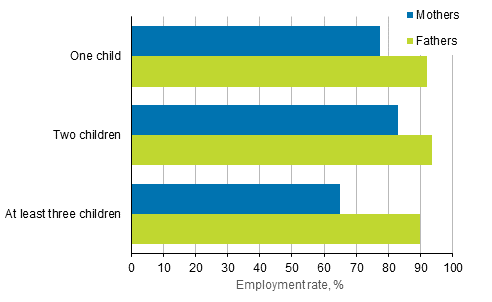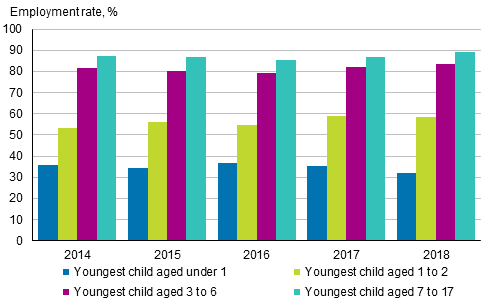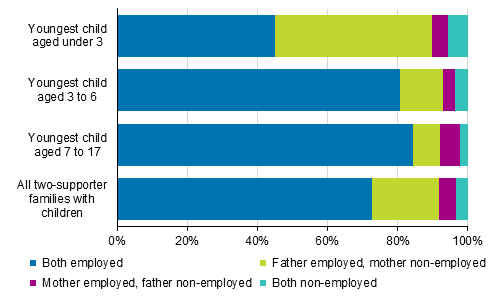3 The number of children and their age affect mothers’ labour market position
The number of children under the age of 18 in the family affect especially the employment of mothers. On average, 80 per cent of mothers with one or two children were employed, while of mothers with at least three children 65 per cent were employed in 2018.
The employment rate of mothers with two children aged under 18 rose most, from 78 per cent in 2014 to 83 per cent in 2018. The employment rate of mothers with three or more children increased by two percentage points over the same period, while that of mothers with one child remained unchanged at 77 per cent during both years.
The employment rate of fathers has for several consecutive years been around 90 per cent regardless of the number of children. (Figure 3.)
Figure 3. Employment rates for fathers and mothers aged 20 to 59 by number of children in 2018, %

The age of the youngest child in the family has an effect on the mother's employment, especially when the child is small. However, the employment rate of mothers rises quite quickly as the child grows (Figure 4, Appendix table 1). While 32 per cent of mothers with children aged under one were employed in 2018, this was so for 58 per cent of mothers with children aged one to two, and 84 per cent of mothers with children aged three to six. Among the mothers of school-age children 89 per cent were employed.
Twenty-four per cent of employed mothers with children aged one to two were working part-time in 2018. Mothers’ full-time employment becomes more common as the children grow. Among employed mothers with school-age children (aged 7 to 17) only 11 per cent worked part-time in 2018. Fathers’ part-time employment is very low.
Figure 4. Employment rates for mothers aged 20 to 59 by age of their youngest child in 2014 to 2018, %

In families with underage children with two supporters, fathers usually take shorter family leaves than mothers. During paternity leave or parental or child care leave of under three months, fathers are classified as employed so family leaves have little impact on the employment rate of fathers.
The share of two-parent families where both parents are employed has grown in 2018 compared to 2014. In 73 per cent of all two-parent families with children both parents were employed in 2018 while in 2014 the share was 68 per cent. When the youngest child is between three and six years old, in 81 per cent of the two-parent families both parents were employed, and this is so for 85 per cent of families with school-age children. (Figure 5.)
Although mothers’ employment increases rapidly after the youngest child turns one, it remains below the employment of fathers until the youngest child starts school. In 2018, the employment rate of mothers in two-parent families was 90 per cent when the youngest child reached school age.
Both parents were non-employed in three per cent of families with children with two supporters.
Figure 5. Labour market position of parents in families with children with two supporters aged 20 to 59 by age of youngest child in 2018, %

Source: Labour Force Survey 2018. Statistics Finland
Inquiries: Tarja Nieminen 029 551 3561, Olga Kambur 029 551 3565, tyovoimatutkimus@stat.fi
Director in charge: Jari Tarkoma
Updated 14.11.2019
Official Statistics of Finland (OSF):
Labour force survey [e-publication].
ISSN=1798-7857. Families and work 2018,
3 The number of children and their age affect mothers’ labour market position
. Helsinki: Statistics Finland [referred: 18.7.2024].
Access method: http://www.stat.fi/til/tyti/2018/14/tyti_2018_14_2019-11-14_kat_003_en.html

